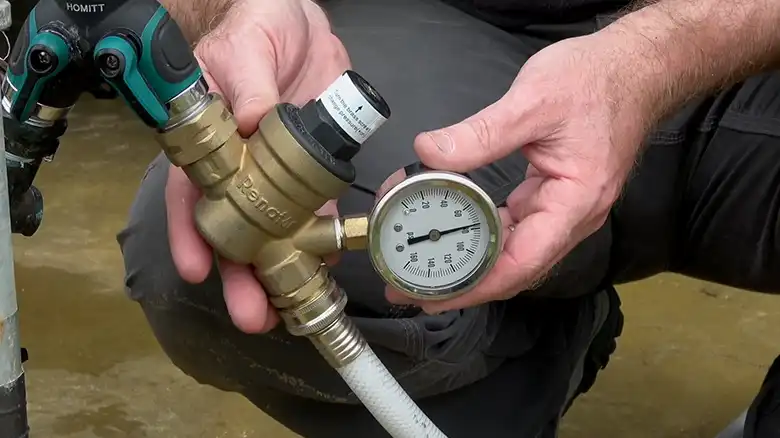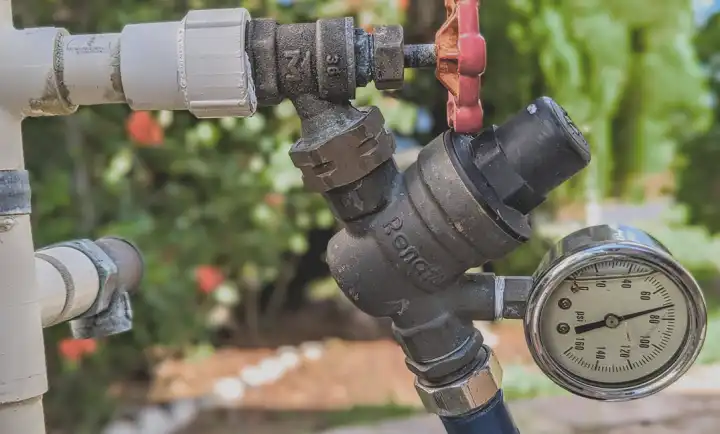A few things perturb me more than unexpected plumbing headaches disrupting well-laid travel plans. Like nervous homeowners fretting during rainstorms, I find myself eying piping warily as water flows on board my motorhome. What catastrophic leaks or burst lines lurk behind these walls? My mind races imagining all possible soak-worthy calamities from failing fixtures!
Overdramatic? Perhaps. Yet RV forums teem with panicked threads blaming mysterious leaks or pump failures on vague “over pressurization.” Is there genuinely such a thing as too much water pressure for RVs? If so what constitutes overages – and how much margin of error exists before hitting critical danger zones? I decided understanding max safe water pressures deserves equal priority to routing the perfect national park excursion.
After consulting physics guides and then dissecting component specifications between sips of wine, I’ve emerged far more water pressure savvy. This article summarizes key learnings around RV pressure limits, consequences of overages, plus best practices for balancing adequate flow rates against component protections for stress-free sojourns.

Defining Maximum Water Pressure for RVs
Let’s start by translating this warning signpost – “water pressure” – into precise terminology conveying why it requires vigilant respect aboard RVs.

Measured in PSI
Plumbing equipment withstands force applied over surface areas before leaking or destruction. Within fluid dynamics physics, the amount of pounds per square inch (PSI) denotes force exertions applied by liquids against pipes, seals, pumps, and overflow valves. Too little pressure causes frustrating trickles from faucets. But excessive pressure stresses materials beyond strength thresholds causing failures.
Gravity Adds Pressure
Water gains pressure naturally via gravity – height translates directly to greater force applied by accumulating liquid volumes. City plumbing piping across multiple building floors sees pressure build thanks to vertical rise. And RVs parking on steep campground slopes or angling uphill on driveway court added gravity-augmented pressures taxing weak points. This explains why motorhome manuals sternly warn against extreme-angle parking!
Externally Sourced Pressures
While topography and internal pump positions influence onboard pressure baselines, the most volatile risk comes from external city water sources that RVs connect to. Municipal utility services typically supply household taps between 40 to 60 PSI to satisfy typical multi-story building needs. That easily doubles the pressures RV plumbing components tolerate for continuous flows if left unchecked!
So in summary, “max water pressure” represents peak tolerances before gravity feeds or municipal overages catastrophically over-stress RV pipes and seals causing irreversible failures. Keeping usage within limits prevents dire plumbing consequences.
Consequences of Exceeding Max Pressure
Before exploring ideal target thresholds, let’s first dissect the ramifications of allowing pressures to spike beyond equipment protections absent proper regulation. Physics leaves little latitude once weaknesses get exposed:
Pipe and Hose Bursts
Excess pressure overwhelms junction seals causing dramatic ruptures spraying water widely until shutoffs kick in. Pliable supply hoses prove particularly vulnerable to rapid failure when used without pressure regulation. Expect disastrous flooding as seams blow open!
Waterlogged Materials
Even small leaks caused by excessive pressures soak absorbent insulation, wood framing and underlayment materials once left undetected from outer surface visibility. This accelerates mold formation and structural deterioration issues over time.
Pump Burnout
Constantly forcing water at abnormally high rates rapidly wears out interior supply pump components causing premature need for replacements. Expect another messy site as failed pumps spill contents until depleted.
Financial Floodgates
Beyond the physical damage, owners also face staggering repair expenses from extensive disassembly work required to access and replace burst plumbing runs or water-logged structures. Hours of labor, building materials, and demolished furniture add up devastatingly fast. Far cheaper to throttle pressures proactively!
Clearly, uncontrolled water force takes a heavy toll on RVs never designed to withstand household line strengths enterally. So what constitutes reasonable pressure limits to observe?
Target Water Pressure Limits for RVs
General consensus across builders and fluid mechanics experts advises maintaining around 45 PSI peak onboard pressure for typical RVs models. This satisfies appliance flow rate needs while sustaining integrity across common outlet fixtures, piping, pumps, and seals preventing frequent leaks or failures.
Of course, exceptions exist – lightweight portable campers with basic demands operate reliably at lower 35 PSI targets. And some luxury coaches or fifth wheels with residential-grade plumbing accommodate intermittent 50-60 PSI spikes – but continuous maximum pressures still hover around 45 PSI for most RVs across service manuals.
Ideally target 40-45 PSI maximums, then allow momentary 50 PSI peaks – just long enough for quick appliance usage. Exposing entire systems to sustained pressures beyond 45 PSI through neglecting regulation risks Component stress over time.
Why Do Pressure Limits Vary Across RV Types?
If physics dictates pressure tolerances, why don’t all RVs share identical max PSI bands? Understanding key structural differences explains the variability:
a) Construction material grades – plastic vs reinforced tubing
b) Pipe routing complexity from length and elbows
c) Diameter widths varying friction rates for specific runs
d) Seal designs – threaded, clamped, or soldered joints
e) Appliance pressure minimums – some need 50+ PSI
f) Weight limits across chassis and mounting points
Luxury motorhomes boast residential kitchen wares demanding 50-60 PSI for cooktop combustion or rapid sink fills. Their customized plumbing grows accordingly robust against higher baseline limits. Whereas compact trailers feature simpler routing and cheaper fixtures intentionally for weight savings and value price points. One-size pressure tolerances rarely fit all RVs!
How Do Owners Determine Their Exact RV’s Limits?
Rather than memorizing generic 45 PSI guidance, customizing targets based on your specific RV’s fluid system and appliance capabilities proves the smartest. Three key reference sources help owners identify targeted limits:
1. Manufacturer Manuals
Every RV model manual prescribed by the original builder offers tailored guidance around onboard pressure thresholds and external regulation needs. Consult manuals first for rated tolerances across appliances and labeled components. Manual directives carry authority knowing exact equipment integrated across floorplans.
2. Dealer Specifications
Credible RV dealerships always communicate pressure specifics matching connected city flow rates against system handling maximums for both guidance and compliance. Reputable retailers highlight regulators appropriate for vehicles during sales discussions. Confirm any guidance with the technician’s services department.
3. Certified Technician Consultations
Board-certified RV service technicians undergo extensive training on system diagnostics and custom requirements across RV equipment and use cases. Scheduling an inspection consultation allows you to assess your model’s pressure handling capably based on age, routing, and noted appliances. Techs also validate protections match needs for regional utilities supplying camp properties. There simply is no substitute for qualified expert advice catered to your particular RV!
Using combined wisdom from these sources, owners discern the sweet spot sustaining both ample appliance functionality and plumbing protection across travels near or far.
Regulators: The First Line of Pressure Defense
After defining needs, plumbing regulators represent the most vital proactive protective barrier shielding RVs from hazardous municipal overpressures. These precalibrated valves are installed inline along exterior water hookups to actively reduce and stabilize input rates down to preset targets suitable for each RV model.
Regulators combat three hazards in real-time:
1. Overpressure Prevention
Their sole purpose involves throttling erratic city feed fluctuations down below labeled RV pressure maximums – typically 60 PSI surges reduced to 45 PSI for example. Preset outlet thresholds prevent spike force levels from exceeding equipment whitelist allowances from ever reaching interiors.
2. Pressure Stabilization
Regulators also smooth out variable urban supply pressures down to steady streams compatible with RV demands. This prevents appliances and fixtures from coping with distracting flow inconsistencies all through usage cycles.
3. Adjustable Limiting
Upon installation, owners can fine-tune regulator pressure relief points based on manuals or tech guidance defining RV limits. Adjust dials to align target thresholds to equipment needs rather than guessing flow rates.
Installing aftermarket regulators at campsites whenever utilizing external water hookups provides the simplest method of preventing pressures from overwhelming recreational vehicle plumbing clearly unable to withstand direct city line conditions indefinitely.
Think of them as gates ensuring only RV tolerable current passes beyond connection points!
Gauges Offer Real-Time Peace of Mind
Once regulators actively limit feed rates externally, adding interior water pressure gauges allows proactive monitoring for any variability escaping presets. Much like engine dashboard readings, visible PSI displays alert owners to the moment pressure trends beyond expected bands.
This real-time feedback proves invaluable in observing external utility consistency, troubleshooting regulators’ slipping tolerances, or diagnosing developing system leaks subtly influencing readings. Gauges essentially act like check engine lights over critical plumbing vitals!
RV supply centers offer compact gauge panels blending seamlessly into appliance clusters once wired to internal water lines. Their small added expense pays peace of mind dividends down road miles!
Seeking Professional Assistance
While armchair physics provides DIYers confidence around basic pressure concepts, hands-on technical experience always outsmarts textbook familiarity when applying science across unique RV models and real-world contexts. Seek assistance from experts!
Inspections – Certified RV technicians conduct extensive plumbing health checks and pressure testing baselining tolerances and regulator needs for your particular water systems and usage plans. They identify risks and fine-tune regulators saving owners costly trial and error guesses. think of it as a physical exam for RVs!
Preventative Upgrades – If inspectors discover component deficiencies or weaker factory fixtures vulnerable at standard pressures, they also advise impact-resistant replacement parts and added seals reinforcing integrity. An ounce of upgrade prevention outweighs flood damage pound cures later!
Winterization – Technicians help properly purge all onboard water systems when freezing conditions approach. They drain pipes fully and then fill cleared channels with antifreeze protecting against ice expansions and catastrophic burstsowners overlook when tackling themselves. Wintertime insurance is well worth the consult fees!
While respecting pressure limits and regulators empowers owners crucially, embracing professional wisdom and services ensures you make the most educated choices rather than simply wishful thinking. Partner with specialists able to quantify recommendations expertly.
Key Takeaways Any RV Plumbing Pressure Master Knows
Through both scholarly and practical research around RV water systems, several pivotal pointers stand easing pressure planning for smooth touring ahead:
🔅 Expect external water sources to deliver excess pressures – install regulators to prevent failures
🔅 Consult manuals and technicians to define pressure limits specific to your RV model
🔅 Add gauges permitting real-time monitoring regardless of regulation
🔅 Appreciate pressure demands scale across RV types and equipment
🔅 Embrace preventative upgrades and winterization using expert assistance
🔅 Pressure awareness promises safe, uninterrupted adventures for years beyond!
Armored with enhanced pressure insights, I for one find myself gazing at plumbing less suspiciously on journeys nowadays. Perhaps I’ll retrain those nervous impulses soon viewing fixtures instead as trusted traveling companions!
Below I’ve compiled some supplemental commonly asked questions around RV pressure considerations. Feel free to browse additional Smart RVing tips as well during your voyaging preparations!
Common FAQs
If regulators supposedly govern pressures externally, why bother monitoring interior gauges also?
Even calibrated regulators allow some narrow deviation from preset limits – gauges provide alerts around slipping tolerances. Gauges also detect internal leaks influencing pressure otherwise unregulated. Redundant monitoring improves detection.
Do portable water hoses themselves have distinct pressure limitations?
Absolutely – conventional hoses sustain around 100 PSI typically before seam vulnerabilities manifest. Exceeding this threshold externally risks bursts despite regulators protecting interiors. Upgrade to durable hoses rated above utility company feeds.
During freezing conditions, should RV water systems have remaining liquids purged fully with compressed air to ensure emptying?
No, attempting to purge plumbing with compressed air risks injecting pockets of water missed during draining into intricate piping at pressure levels causing ice damage. Systems with water valves closed and then liquid lines fully drained require no further air drying.


